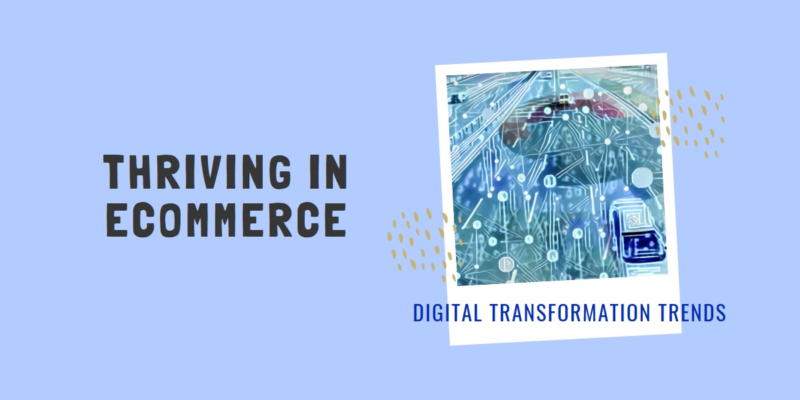
The landscape of eCommerce is constantly evolving. Customer expectations are at an all-time high, and businesses need to adapt or risk getting left behind. This is where digital transformation comes in. It’s not just a buzzword; it’s a strategic approach to leveraging technology to improve operational efficiency and, most importantly, enhance the customer experience.
The Stats Speak for Themselves
- 73% of all retail sales growth is expected to come from eCommerce by 2025 [Source: Shopify Future of Commerce Report 2023].
- 84% of shoppers say that the experience a company provides is as important as the products or services they sell [Source: Salesforce: State of the Connected Customer].
These numbers paint a clear picture: Meeting customer expectations is no longer a choice, it’s a necessity. So, let’s delve into the key digital transformation trends that eCommerce businesses can capitalize on to thrive in this dynamic environment.
1. The Rise of AI and Machine Learning
Artificial intelligence (AI) and machine learning (ML) are revolutionizing eCommerce by providing businesses with unparalleled customer insights and automation capabilities.
- Personalization: AI can analyze customer data to personalize product recommendations, marketing messages, and offers. This creates a more engaging and relevant experience for shoppers, leading to increased satisfaction and conversion rates.
- Chatbots and Virtual Assistants: AI-powered chatbots can handle basic customer inquiries 24/7, freeing up human agents for more complex issues. Virtual assistants can even assist shoppers in real-time, guiding them through product selection and checkout.
- Demand Forecasting: Machine learning algorithms can analyze historical sales data and market trends to predict future demand. This allows businesses to optimize inventory management, minimize stockouts, and improve overall supply chain efficiency.
2. Omnichannel Excellence
Today’s customers expect a seamless shopping experience across all touchpoints – online store, mobile app, social media, and even physical stores (if applicable).
- Unified Shopping Cart: Customers should be able to add items to their cart on one device and complete the purchase on another.
- Click-and-Collect: Offer customers the convenience of buying online and picking up in-store.
- Social Commerce Integration: Allow customers to discover and purchase products directly through social media platforms.
3. The Power of Data Analytics
Data is the lifeblood of any successful eCommerce business. By leveraging data analytics tools, businesses can gain valuable insights into customer behavior, marketing campaign performance, and operational efficiency.
- Customer Segmentation: Identify customer groups with similar characteristics and tailor marketing campaigns and product recommendations accordingly.
- A/B Testing: Test different website elements, email content, and marketing strategies to see what resonates best with your audience.
- Attribution Modeling: Understand which marketing channels are driving the most sales and optimize your marketing spend.
4. Embracing Mobility
With the ever-increasing use of smartphones and tablets, mobile commerce (mCommerce) is booming.
- Mobile-Friendly Website: Ensure your website is responsive and optimized for mobile devices.
- Mobile App: Consider developing a native mobile app to provide a more personalized and convenient shopping experience.
- Mobile Payments: Offer a variety of secure and convenient mobile payment options for a faster checkout process.
5. The Future is Frictionless: Automation and Streamlined Operations
Automation is key to streamlining operations and improving efficiency in an eCommerce business.
- Robotic Process Automation (RPA): Automate repetitive tasks such as order processing, data entry, and inventory management.
- Warehouse Automation: Utilize robots and other automated systems to optimize picking, packing, and shipping processes in your warehouse.
- Cloud-Based Solutions: Leverage cloud-based solutions for tasks like CRM, ERP, and marketing automation to improve scalability and accessibility.
Logistics with IoT and Smart Tech: Optimizing the Last Mile
While not strictly a digital transformation trend itself, the integration of Internet of Things (IoT) and smart technologies can significantly enhance the efficiency and visibility of your logistics operations. P99Soft, for example, can assist eCommerce businesses with these advancements.
Imagine real-time tracking of shipments, smart warehouses that optimize storage and retrieval, and self-driving delivery vehicles (a concept still in development but with vast potential). These are just some of the ways IoT and smart technologies can revolutionize the last mile of the eCommerce journey.
FAQs
- How can I get started with digital transformation?
Start by conducting a thorough assessment of your current business processes and technology stack. Identify areas for improvement and prioritize which digital transformation trends will have the biggest impact on your business.
- What are the biggest challenges of digital transformation?
Some common challenges include resistance to change,securing funding for new technologies, and integrating new systems with existing infrastructure. However, with careful planning and execution, these challenges can be overcome.
- Do I need to completely overhaul my entire business model?
Not necessarily. Digital transformation is a journey, not a destination. You can start by implementing smaller changes and gradually scale up as you see results.
- How can P99Soft help my eCommerce business?
P99Soft offers a range of digital transformation consulting services that can help your eCommerce business capitalize on the trends mentioned above. Their expertise in Logistics with IoT & Smart Tech can specifically address last-mile delivery challenges and optimize your fulfillment operations.
Conclusion
The digital transformation landscape is constantly evolving, presenting both challenges and opportunities for eCommerce businesses. By embracing key trends like AI, omnichannel experiences, data analytics, mobile commerce, and automation, businesses can elevate the customer experience, streamline operations, and gain a competitive edge. But remember, digital transformation is an ongoing process. The key is to stay informed, adapt to changing customer needs, and continuously innovate to stay ahead of the curve.
So, what trends are you most excited about implementing in your eCommerce business?
Also know Our target audience is IT and technology companies










